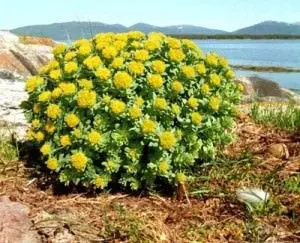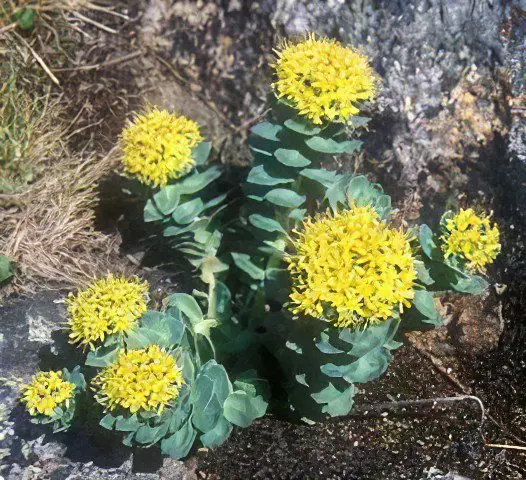Useful properties and application of infusion and tincture of Rhodiola rosea
Botanical characteristics of Rhodiola rosea

Rhodiola rosea – herbaceous perennial plant, growing no higher than half a meter. The plant has a thick and powerful rhizome and fleshy roots. On erect stems, cup-shaped leaves are located, which are painted dark green at the top of the stem. At the top of the stem is the apical inflorescence. The leaves of the plant are sessile, may be elliptical or oblong. The edges of the leaves have uneven teeth. Rhodiola flowers are unisexual. Yellow medium-sized flowers of the plant are collected in a corymbose inflorescence.
Rhodiola fruit is a leaflet, the color of which is red and yellow-green. The plant blooms from June to August. The fruits ripen in August.
The plant is found on rocky placers, in the plain tundra, on rocks, on the banks of a mountain river and stream. Rhodiola grows in Russia, in Eastern Kazakhstan and in the regions of Siberia.
Propagation of Rhodiola rosea
Rhodiola is most often propagated by seeds. Sowing seeds is carried out either in late autumn or in winter. Seeds are sown in a box with nutritious soil, into which air easily penetrates. At the bottom of the box should be expanded clay. A weak solution of potassium permanganate is poured into the soil and compacted a little. Further, the seeds of the plant are evenly distributed over the entire surface, slightly pressing them. Sand is poured over the seeds with a layer of 2 mm. A film is thrown over the box and the box is taken out to the balcony (you can go to the garden). In March, the box should be moved to a warm, well-lit place. After a couple of days, shoots will appear. Now we remove the film and water the seedlings carefully and slowly. Seedlings are transplanted when they have 2 true leaves. Transplantation is carried out with the help of a match, which needs to be made a hole and a match to hook the plant along with a piece of earth and transfer to a new hole.
Rhodiola can be propagated by dividing the rhizomes. This requires plants that are at least 2 years old, and whose rhizomes weigh at least 30 grams. The rhizome is divided into 2 parts, and the cut is treated with ash. Ready rhizomes are planted in prepared holes, in which there is already humus in the amount of 900 grams. Compost or humus is also poured over the rhizomes, but renewal buds should be on the surface. A little watering the rhizomes, make mulching with peat.
Useful properties of Rhodiola
Rhodiola has many beneficial properties, for example, it improves heart function and increases blood pressure, promotes the release of bile. The roots of the plant contain substances that are used to stop bleeding and restore the body’s strength after great overwork. Rhodiola is used as an excellent tonic and sedative.
Rhodiola is used for poor appetite, metabolic disorders and inflammation of various kinds. Rhodiola preparations are also used as an antipyretic or anti-allergic agent. Rhodiola treats acute and chronic radiation injuries, overheating or hypothermia. Rhodiola quickly heals wounds, improves eyesight and increases hearing acuity.
Rhodiola tincture is used as a stimulant for the central nervous system. Rhodiola has a good effect on pulmonary tuberculosis, skin diseases and bone fractures. Rhodiola also has a general strengthening effect. It is used not only inside the body, but also externally, it has also found application: they make lotions and baths.
The use of Rhodiola rosea

Rhodiola treats many diseases and ailments, and this is due to the beneficial substances contained in it. It is used for diarrhea, headache, scurvy, menorrhagia, gout, scrofula and diabetes. Externally Rhodiola is used to treat conjunctivitis, abscesses, skin rashes. Its juice can lubricate the gums with pyorrhea. Rhodiola juice cleanses wounds. Preparations from Rhodiola help with impotence, gynecological diseases and anemia.
Rhodiola tincture. To prepare it, you need to take 50 grams of the root of the plant and grind it into powder, pour it with 2 glasses of vodka. Leaving to infuse for 14 days in a dark place, shake occasionally. After straining the finished tincture, it is taken 20-30 drops three times a day for half an hour before meals. This tincture is also taken by people who have a tendency to hypotension, although at first the tincture should be taken no more than 5 drops three times a day (but over time, the tincture is taken up to 10 drops).
Collection to improve immunity. Take 20 grams of rhodiola roots, the same amount of lure roots and rose hips. Here, add 15 grams of hawthorn and nettle fruits as much. It remains to add only 10 grams of St. John’s wort to this mixture. Now we take 1 tablespoon of the collection and pour a glass of boiling water. Put on fire for 10 minutes and remove from heat. Leave for 4 hours to infuse and filter. The raw material from the broth must be squeezed out and thrown away, and then add boiling water to make it about 200 ml. Take a ready-made collection of 70 ml three times a day.
Rhodiola infusion for colds, heart weakness. We take 10 grams of the roots of the plant, grind them and pour a glass of boiling water. Leave for 4 hours to brew and filter. Take a ready-made infusion of half a glass three times a day. This infusion is used for nervous diseases and diseases of the gastrointestinal tract.
In folk medicine, for the effective treatment of such serious diseases as diarrhea, menorrhagia, fever, headaches, scurvy, decoctions containing Rhodiola rosea are used. This herb is often prescribed for respiratory infections, to relieve fatigue and effectively increase efficiency. Rhodiola rosea is effective in scrofula, diabetes, anemia, stomach disorders, impotence and severe toothache.
With conjunctivitis and all kinds of skin problems, the plant is prescribed externally in the form of poultices and lotions, which are also effective for treating gums with pyorrhea (gum festering). Moreover, preparations with pink rhodiola are indicated for various gynecological diseases.
To increase immunity, it is recommended to mix 20 grams of pink rhodiola roots, 20 grams of rose hips, 15 grams of ripe hawthorn fruits, 10 grams of St. John’s wort, and 20 grams of dense lure roots. For one and a half tablespoons of this mixture, you should take a glass of boiling water. Pour the mixture with boiling water and boil for 10 minutes. After 4 hours of infusion, it is necessary to strain the product and squeeze out the raw materials. Add boiling water to the resulting broth to make a glass. The decoction should be taken 60-70 ml 3 times a day. This tool can also be used for lotions.
To stimulate the central nervous system, it is recommended to use alcohol tincture.
Rhodiola rosea root
For medicinal use, rhizomes are isolated from Rhodiola rosea. They should be harvested in July or August. To do this, it is necessary to dig up the roots, thoroughly wash them from particles of earth in cool water, then clean them from brown cork and rotten parts. After that, you need to cut the rhizome across into small pieces, the length of which will be about 10 cm. And only then dry the raw material at a temperature of at least 50 ° C.
Rhodiola rosea tincture
For the correct preparation of such a remedy, it is recommended to take 50 grams of crushed plant roots, which should be poured with 400 grams of vodka. After that, set aside the mixture to infuse in a dark place for 14 days. It is advisable to shake the container once every few days. Before use, we filter the finished tincture and use it first, 5 drops each, gradually increasing to 20 drops. The tool is used orally 20 minutes before each meal. Such a wonderful tincture is indicated for patients prone to hypotension.
Infusion of Rhodiola rosea
Therapeutic infusion of pink rhodiola is prescribed for heart weakness and frequent colds. To prepare it, we take 10-15 grams of roots, which we carefully grind and pour 250 grams of boiling water. After 4 hours, the mixture must be filtered through a fine strainer or gauze. A ready-made infusion is taken at 80-100 ml 3 times a day. It should also be noted that this remedy is indicated for ailments of the gastrointestinal tract and for nervous diseases.
Rhodiola rosea decoction
Miraculous decoctions of pink rhodiola significantly improve the functioning of the heart and the important cardiovascular system. Vessels become stronger, more functional and more resilient. Often a decoction is prescribed for diseases of the gastrointestinal tract, uterine bleeding, and also for impotence. This remedy contributes to the effective treatment of the thyroid gland and regulates blood sugar levels. With toothache and anemia, such a wonderful decoction will greatly alleviate the patient’s condition. And also a healing decoction from the upper part of pink Rhodiola is used for cosmetic purposes to wipe the skin.
Rhodiola rosea for children
Various decoctions and tinctures of pink rhodiola, as well as numerous preparations containing this herb, are not recommended for children who are under 12 years old. Otherwise, skin rashes, nausea and vomiting may occur.
Rhodiola rosea contraindications
Despite the fact that Rhodiola rosea normalizes blood pressure, both low and high, nevertheless, it should not be taken in severe hypertensive crisis! Since this herb has a stimulating effect.
In addition, the dosage of the drug prescribed by the doctor should be strictly observed.









